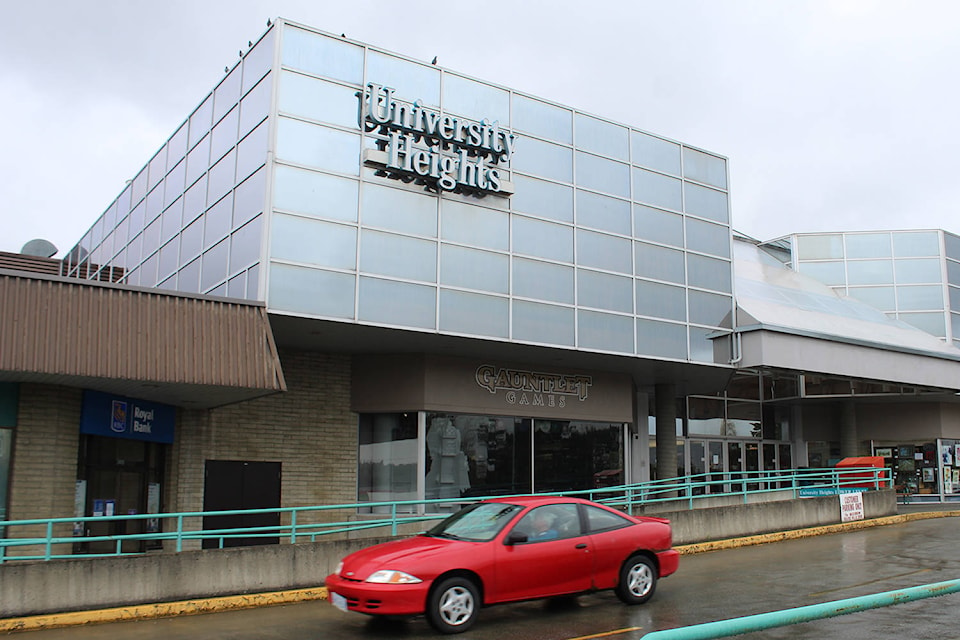Disagreements about the appropriate supply of affordable housing and development cost charges among other reasons have held up the proposed re-development of Saanich’s University Heights.
Official municipal documents list the project on hold after Wesbild had already held two open forums during which it had presented its plans for the re-development of the shopping area.
Plans first presented to the public in 2018 call for the construction of 367 residential units and new commercial space totaling 192,000 square-feet at the corner of Shelbourne Street and McKenzie Avenue, a crucial, if not strategic element of Saanich’s Shelbourne Valley Action Plan.
Steve Forrest, Wesbild’s senior vice-president of real estate, said his company is currently “tweaking the development to make it financially viable” after receiving input from the municipality and the public at large. Proposed changes include shrinking the commercial share of the project, lowering its maximum height to six stories from eight, and making all units available for rental.
RELATED: Documents show re-development of Saanich’s University Heights on hold
When asked about the likelihood of the project going forward, Forrest said he would give it odds of 60-40 in favour of going ahead, adding that he would have given the project the same odds before the current review.
Ongoing areas of disagreements include the size and scope of community amenities, specifically the amount of affordable housing. Forrest said the company is prepared to make up to 10 per cent of all units — some 35 units — ‘affordable’ with the definition to be worked out. But Forrest questioned calls for higher figures to be enshrined in perpetuity.
He said Saanich along with the community at large should look at the whole project. With 100 per cent of all units going into the rental pool, it will help fill a regional gap in the rental supply, he said. Wesbild has also offered to improve the urban infrastructure around the area. Other proposed elements such as integrated green space and a for-profit-daycare serving residents should also count towards community amenities, he said.
“You have to look at the whole context of the project,” he said.
Other issues concern Saanich’s decision to raise development cost charges (DCCs) and slow processing times. “That [DCCs] is very significant for our project,” he said in expressing hope that Saanich would grandfather the project under the old structure. Forrest also said that going back and forth with staff has been “quite slow.” Forrest said he estimates that a “minimum of two years” would pass between now and start of construction. Wesbild’s tenants, he said, would like some certainty as well.
Forrest said Wesbild has been cooperating with Saanich staff during the course of what he described as “some good discussions.” But he also said that staff needs to qualify its expectations. “It’s not a question of being pushed around, but when do you run out steam?” he said.
Responding to these various issues, Kelsie McLeod, a spokesperson for the District of Saanich, said community contributions are negotiated with applicants, specific to the project and neighbourhood.
“It’s important to note that there is no set requirement for community contributions for proposed development applications in Saanich,” she said. Similar to other municipalities, it is up to the applicant to determine a suitable option.
“Saanich is not demanding perpetuity [on the question of the affordable housing],” she said. “Staff have suggest to the developer that this is an area where [council] and members of the community have expressed interest in ensuring perpetuity for affordable housing if it is being identified as an amenity contribution to the community.”
She added later that Saanich is also not demanding a minimum figure of affordable housing. “Saanich has simply been providing suggestions,” she said, when asked about the 10 per cent figure.
As for development cost charges, McLeod said staff have reviewed the DCCs and their implementation at some length with Wesbild. “Opportunities for grandfathering remain; however, they are largely dependent on the timing of the proponent and the receipt of a complete application,” she said.
RELATED: Plans for University Heights redevelopment could go to Saanich council by end of year
McLeod said Saanich has allocated what she called “ample resources” to this project, adding staff have spent a significant amount of time assisting the proponent to date. “The applicant retracted the previous development application and has been working on significant changes from their previous submission,” she said. “At this point, Saanich has not received a complete application for the revised proposal.”
Planning staff, she said, are committed to a timely review process, so that council can consider the proposed development when the proponent has completed their revisions and resubmitted a complete development application.
“Staff will continue to work with the proponent to ensure the application meets all of the development requirements so that the proposed development has the greatest likelihood of support from the community and from [council],” she said.
Like us on Facebook and follow us on Twitter
wolfgang.depner@saanichnews.com



